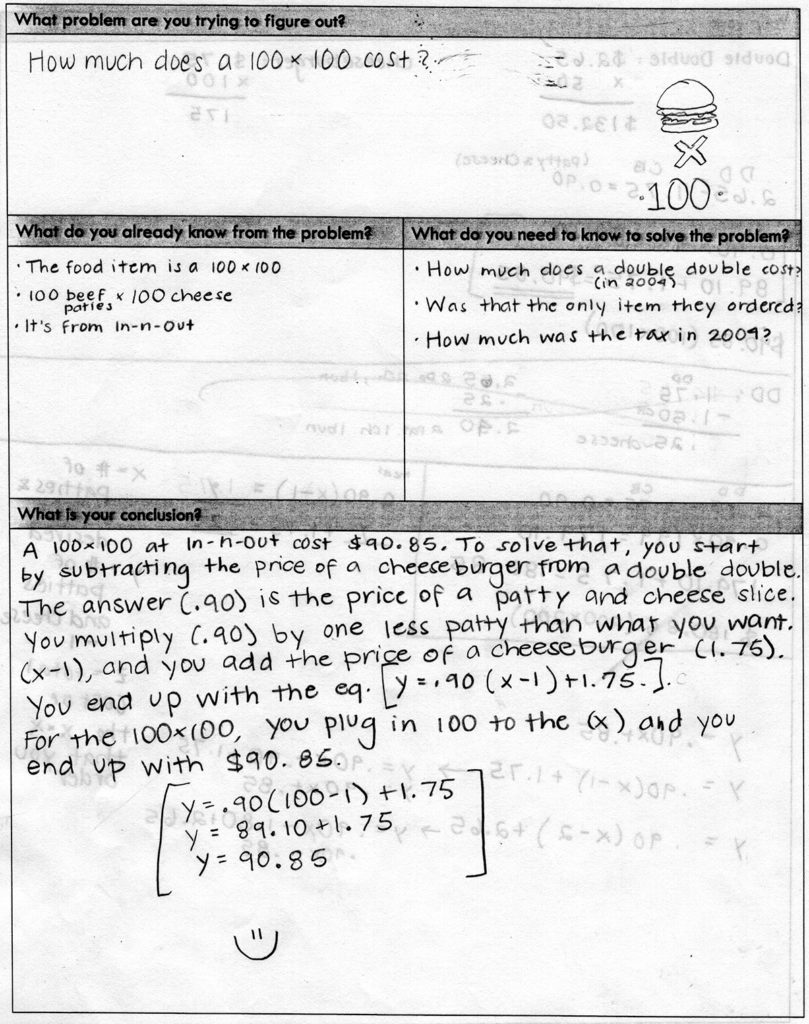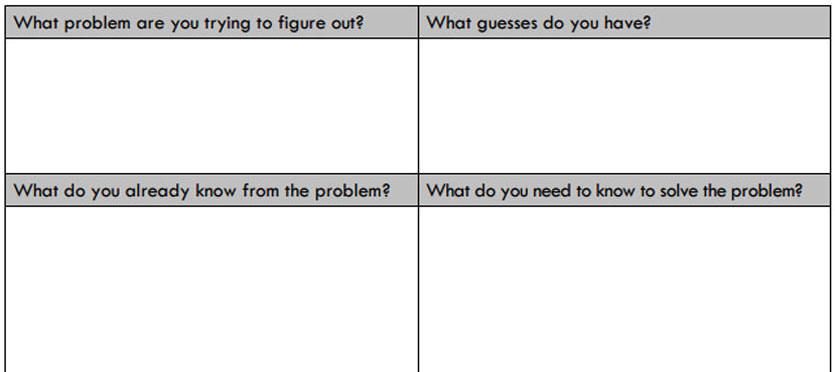My favorite tool for helping students solve problems is the Problem Solving Framework. I love using it because it scaffolds students often underdeveloped critical thinking skills and helps them develop their own problem solving techniques.


The original version came from Geoff Krall. As of writing this, I am currently on version 7.3 of the Problem Solving Framework. Clearly you don’t get to version 7.3 by getting it right on the first try. The reality is that it I have been continually refining the tool as I add sections or take others away. For example, I didn’t originally have a place for students to take a guess. I would try to have students do it during class, but would often forget. So, I added it to the framework.
Here are six sections in the Problem Solving Framework as well as some thoughts about each one:
- What problem are you trying to figure out?
- This is where students write down the main task or question. If you discuss several potential questions during class, you might want to have students peek at their classmates’ paper to make sure that everyone has roughly the same question.
- What guesses do you have?
- Asking students to take a guess helps them engage with the problem solving process. The act of taking a guess makes you reflect on a possible strategy for solving the problem, and leads into the next row beautifully. Note that guesses could be “best guess”, “a guess you know is too low and a guess you know is too high”, or even “a guess you know is definitely wrong”. All of these will get them thinking.
- What do you already know from the problem?
- This is where students will start to inventory the information the already know from the problem. Sometimes it may have all the students need. Other times it may be nearly empty.
- What do you need to know to solve the problem?
- Students may have trouble with this section because many commonly used problems give students all the information they need. As a result, the ability to think about what information they need to acquire may be underdeveloped.
- What is your conclusion? How did you reach that conclusion?
- Even though this section is on the bottom of the first page, it is the last one completed. I put it on the front so it is easier to scan as a student work sample. It is filled in after students have solved the problem and recorded their work in the “Your work section”. This is where students marry the math content with the context from the problem. I tell kids that “this is where you get to show off” and how I want them to explain how they solved the problem. If two students got the same answer but using different methods, I would certainly expect that to be obvious in this section because the description of how they solved it should match the method they used.
- Your work
- This is the large section on the back of the double-sided sheet where students do the majority of their problem-solving and calculations.
Here’s an example of a completed Problem Solving Framework that was used to solve this problem about finding the cost of an absurdly large cheeseburger.



Hi, I love it! A routine for all students or justbfor thise needing support? Thoughts: I do have an uneasy feeling with the “guesses” box… maybe prediction? Estimate? Maybe expectations? (What do you expect to get as an answer or what range do you expect your answer to be in).
Hi Sarah. This is DEFINITELY a routine for all students. I’d probably make the case that all students need support if given a problem of the proper difficulty level.
Interesting point about the guess. I’ve never had an issue with that wording and I’ve used it hundreds of time. It is easily tweakable if it’s not giving you the results you want.
I recently finished an MA research paper on developing strategies for solving word problems using similar recording sheets as part of a process called Reciprocal Reading. Developed by maths teachers in Victoria, Australia, it’s based on Palinscar and Brown’s Literacy approach, Reciprocal Teaching, which aims to foster comprehension.
In RR, after the predicting, clarifying and solving stages (which can be done collaboratively), there is then an individual summarising stage, where the learners have to self reflect on their strategies and suggest ways to work more effectively next time. I found that the self reflection stage gave me a deeper insight into individual learner’s working and challenges.
Overall, I found the process very worthwhile, it allows for a high range of differentiation and encourages collaborative leaening, though getting the students used to the form filling can take some time and a lot of scaffolding.
It’s also worth noting that the four stage process is also very similar to Polya’s How to Solve It.
Wow. Thanks for your super thoughtful comment. Admittedly, most of the changes I’ve made to this sheet are the result of trial and error, so it’s worthwhile to see that it aligns somewhat to research-based methodologies. I’ll put the resources you mentioned on my reading list to check out. Thanks again!
I am a math coach working with teachers. With recommendation of our math director, this problem solving framework is used by some teachers. When I have recently done my classroom visit, I noticed that students were solving problems step by step via this form, i loved it and praised the teacher for her integration. I also agree with Helen. This recording method allows students to sequence their problem solving plan. It helps with differenciation and collaborative learning.
Thank you for sharing this as well as other resources such as ‘open middle’ .
Hi I tried using well not the same worded framework but a similar version and I failed to inspire the student I worked with to use the format. So I left it and decided I would come back and think about how to do a simple version but now I look at your framework and I was wondering if you have a simple version or if their is a simple version or if you should do a simple version. Additionally I was thinking about chunking it and focusing on chunk by chunk and practice the chunks before working with the whole. I do not know I have not retried to see the results but I intend to. What are your thoughts?
Hmm. I haven’t had those issues. This is my simple version. I would be concerned about breaking it up into smaller chunks than this.
Hi,
When problem solving do you often have students complete a Notice and Wonder? Do you think that the Noticings and Wonderings could be integrated into the format of this problem solving framework I or is it best if the Notice an Wonder is done before as a collaborative group?
Thanks,
Debbie
Hi Debbie. I think the main goal to focus on is that we want students to think deeply about the problem before immediately jumping into computation. Both the problem solving framework and the notice and wonder structure are useful for this. I have seen people combine them into a single document with notice and wonder being the very first things. I haven’t used that myself, but it sounds like a great idea to me.
Robert,
I really like your problem solving framework. Just curious, have you ever used this with general problem solving in life? I think it provides a nice framework for thinking through general problem solving. I am involved in adult education and I see a need for teaching thinking/problem solving skills for those who were not fortunate enough to have been taught this at home. I plan to try it out but wanted to know your thoughts about generalizing this format?
Good question Sarah. I’ve never formally used it, but I sort of think about it when I try to solve problems. I agree, it’s a good framework.
Thank you for sharing your problem solving framework with us. I have used something similar in my work with elementary students. I think frameworks such as these are important tools to help students understand problem solving as a process of inquiry. In my own instructional practice, I often wondered if at some point I should gradually remove the tool in order to foster the internalization of the process. I’ve experienced that some students eventually tire of using the tool because they find it cumbersome to their process, and so my teaching should adapt to accommodate that growth.
I wonder if you have any thoughts about this? Specifically, is it important to gradually remove the tool over time, or at certain times, in order to promote the acquisition of independent problem solving skills?
Interesting question Deb. I haven’t really had much push back from students when using this. You could certainly have them internalize it and use regular paper. The framework itself is fairly minimal.
I’ll keep this in mind though.
We are experimenting with the work around using strategies as described in the NCTM Teaching Children Mathematics journal Vol.23, No. 3 Nov/Dec 2017 “Strategy Keys as Tools for Problem Solving”. I am melding this with your form by adding the questions “Did you need to use more then one strategy? and What where they?” to the conclusion bar. i think it has great potential as we work toward competency in problem solving.
This is great to read Ann. Please share back anything you learn from the process. Thanks!
Would you use this same framework for third grade?
Sure. I’ve used it in third grade with no problem.
Hi! I love the idea of having a consistent problem solving framework across schools / grade levels. I noticed in some of the example work that there is a section at the bottom called “What is your grade” with a place for both students and teachers to mark. I’m curious why it’s not on the version 8.1 framework, and/or if you would advocate for using it still? Thanks so much!
Great question, Jenn. That was something I was playing around with near version 5. I go into my thinking in more detail in this blog post: https://robertkaplinsky.com/the-problem-solving-frameworks-evolution/
I love this framework as a tool for problem solving a really juicy problem. I used to use a similar tool when (back in the day) I would have students solve textbook word problems, and it never was motivating, BUT with a truly meaningful and challenging task/problem I think the need to organize what you know and need to know comes into play and its an effective tool. Thanks for all your resources and ideas, I love using your tasks!